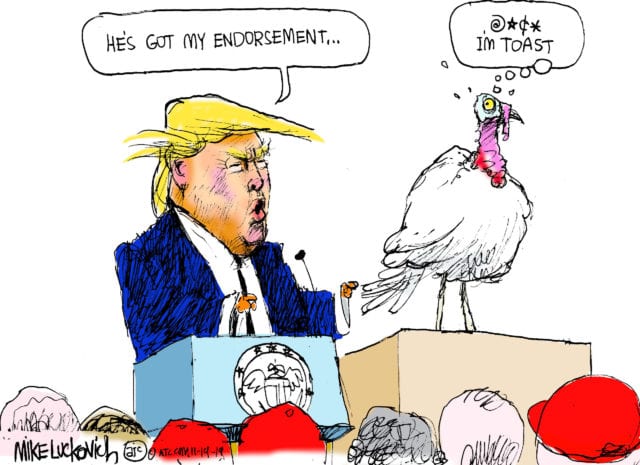I think Louisiana Gov. John Bel Edwards meant it when he partly credited his re-election to LSU’s and the Saints’ winning season. That would be the football teams – Louisiana State University and the New Orleans Saints.
“People are just in a better mood,” the Democrat said. And he did have LSU coach Ed Orgeron vouching for him.
Edwards pulled off a narrow win against a Republican whom President Donald Trump tried mightily to drag into the end zone. Trump was in Bossier City two days before and beseeched his MAGA crowd by saying, “You’ve got to give me a big win, OK?” [In 2016, Trump took Louisiana by 20 points.]
Similar story in Kentucky, where Trump rallies failed to deliver a win for incumbent Republican Gov. Matt Bevin. Democrat Andy Beshear won by only a hair but in a state where Trump scored a 30-point margin.
Well, what were these Democratic victories in the South and the Deep South about? They were partly about several things.
One is that Trump’s magic sauce for energizing his base seems to have lost some potency. And after nearly three years of Trumpian mayhem, he’s energizing voters in the far less friendly cities and suburbs.
But perhaps the deciding factor is that Americans tend to resist efforts by the major parties to nationalize state and local races.
Edwards seemed to be focusing on the issues voters cared about, picking this from column A and that from column B. He raised spending on education and expanded Medicaid coverage, two Democratic causes. But he was far more hostile to abortion and gun control than his party’s mainstream.
Voters are obviously willing to cross partisan lines in state and local elections. And that’s not the case only for Democrats in red territory.
Three of deep blue New England’s six states have Republican governors – Massachusetts, Vermont and New Hampshire. Add to the list liberal Maryland. Their voters tend to be fiscal conservatives and social liberals, and so do their Republican governors.
Successful blue state Republicans steer clear of the ugly chaos in Trump’s Washington just as Democrats in red states ignore the bonfires consuming left-wing Twitter.
That’s how Democratic Gov. Steve Bullock got re-elected in red Montana by four points on the same Election Day Trump took the state by 20. Two years later, another Montana Democrat, Sen. Jon Tester, won re-election – and after Trump visited the state four times to rally support for Tester’s Republican opponent.
All this talk about the Democrats’ moving to the left belies the reality that the party’s resurgence has come from the center. The Democrats’ impressive House majority came not from a handful of radicals winning super safe Democratic districts but from moderates who yanked 40 seats from Republicans.
Former President Barack Obama recently emerged from his silence to remind Democrats of this, warning them to look past “the activist wing” of the party. Don’t assume that the American people want to “tear down the system,” he said. And it is delusional to believe that the voting masses are waiting for something “bold enough” to rev their engines.
Of course, he’s right, and this advice isn’t just useful for liberals. A Democrat now sits in the Kansas governor’s mansion in large part because her Republican predecessor, Sam Brownback, had nearly bankrupted the state with radical and reckless tax cuts. Notably, her Republican opponent, then-Kansas Secretary of State Kris Kobach, campaigned by tying himself to Trump, wrists and ankles.
Could it be that Americans are not quite as politically tribal as we are told? When it comes to state and local elections, it would seem not – and that should apply to national elections as well.







